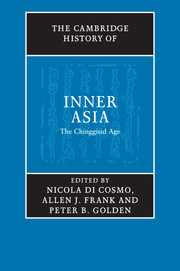28 results
21 - The Stateless Nomads of Central Eurasia
- from Part III - Empires, Diplomacy, and Frontiers
-
-
- Book:
- Empires and Exchanges in Eurasian Late Antiquity
- Published online:
- 13 April 2018
- Print publication:
- 26 April 2018, pp 317-332
-
- Chapter
- Export citation
List of abbreviations
-
- Book:
- The Cambridge History of Inner Asia
- Published online:
- 05 March 2014
- Print publication:
- 27 August 2009, pp xiii-xvii
-
- Chapter
- Export citation
Part Two - LEGACIES OF THE MONGOL CONQUESTS
-
- Book:
- The Cambridge History of Inner Asia
- Published online:
- 05 March 2014
- Print publication:
- 27 August 2009, pp 87-88
-
- Chapter
- Export citation

The Cambridge History of Inner Asia
- The Chinggisid Age
-
- Published online:
- 05 March 2014
- Print publication:
- 27 August 2009
Introduction
-
-
- Book:
- The Cambridge History of Inner Asia
- Published online:
- 05 March 2014
- Print publication:
- 27 August 2009, pp 1-6
-
- Chapter
- Export citation
Part Four - NOMADS AND SETTLED PEOPLES IN INNER ASIA AFTER THE TIMURIDS
-
- Book:
- The Cambridge History of Inner Asia
- Published online:
- 05 March 2014
- Print publication:
- 27 August 2009, pp 219-220
-
- Chapter
- Export citation
Index
-
- Book:
- The Cambridge History of Inner Asia
- Published online:
- 05 March 2014
- Print publication:
- 27 August 2009, pp 466-488
-
- Chapter
- Export citation
1 - Inner Asia c. 1200
- from PART ONE - THE RISE OF THE CHINGGISIDS
-
-
- Book:
- The Cambridge History of Inner Asia
- Published online:
- 05 March 2014
- Print publication:
- 27 August 2009, pp 9-25
-
- Chapter
- Export citation
Part Five - NEW IMPERIAL MANDATES AND THE END OF THE CHINGGISID ERA (18th–19th CENTURIES)
-
- Book:
- The Cambridge History of Inner Asia
- Published online:
- 05 March 2014
- Print publication:
- 27 August 2009, pp 331-332
-
- Chapter
- Export citation
Note on transliteration
-
- Book:
- The Cambridge History of Inner Asia
- Published online:
- 05 March 2014
- Print publication:
- 27 August 2009, pp xii-xii
-
- Chapter
- Export citation
Contents
-
- Book:
- The Cambridge History of Inner Asia
- Published online:
- 05 March 2014
- Print publication:
- 27 August 2009, pp v-vii
-
- Chapter
- Export citation
PART ONE - THE RISE OF THE CHINGGISIDS
-
- Book:
- The Cambridge History of Inner Asia
- Published online:
- 05 March 2014
- Print publication:
- 27 August 2009, pp 7-8
-
- Chapter
- Export citation
Maps
-
- Book:
- The Cambridge History of Inner Asia
- Published online:
- 05 March 2014
- Print publication:
- 27 August 2009, pp xviii-xxviii
-
- Chapter
- Export citation
6 - Migrations, ethnogenesis
- from Part Two - LEGACIES OF THE MONGOL CONQUESTS
-
-
- Book:
- The Cambridge History of Inner Asia
- Published online:
- 05 March 2014
- Print publication:
- 27 August 2009, pp 109-119
-
- Chapter
- Export citation
Bibliography
-
- Book:
- The Cambridge History of Inner Asia
- Published online:
- 05 March 2014
- Print publication:
- 27 August 2009, pp 412-465
-
- Chapter
- Export citation
Part Three - CHINGGISID DECLINE: 1368–c. 1700
-
- Book:
- The Cambridge History of Inner Asia
- Published online:
- 05 March 2014
- Print publication:
- 27 August 2009, pp 155-156
-
- Chapter
- Export citation
List of figure and maps
-
- Book:
- The Cambridge History of Inner Asia
- Published online:
- 05 March 2014
- Print publication:
- 27 August 2009, pp viii-viii
-
- Chapter
- Export citation
List of contributors
-
- Book:
- The Cambridge History of Inner Asia
- Published online:
- 05 March 2014
- Print publication:
- 27 August 2009, pp ix-xi
-
- Chapter
- Export citation
Frontmatter
-
- Book:
- The Cambridge History of Inner Asia
- Published online:
- 05 March 2014
- Print publication:
- 27 August 2009, pp i-iv
-
- Chapter
- Export citation
The Headless State: Aristocratic Orders, Kinship Society, and Misrepesentations of Nomadic Inner Asia. By David Sneath. New York: Columbia University Press, 2007. xi, 273 pp. $50.00 (cloth).
-
- Journal:
- The Journal of Asian Studies / Volume 68 / Issue 1 / February 2009
- Published online by Cambridge University Press:
- 27 January 2009, pp. 293-296
- Print publication:
- February 2009
-
- Article
- Export citation



